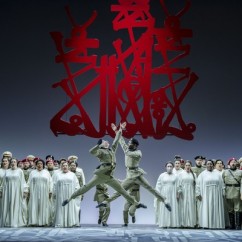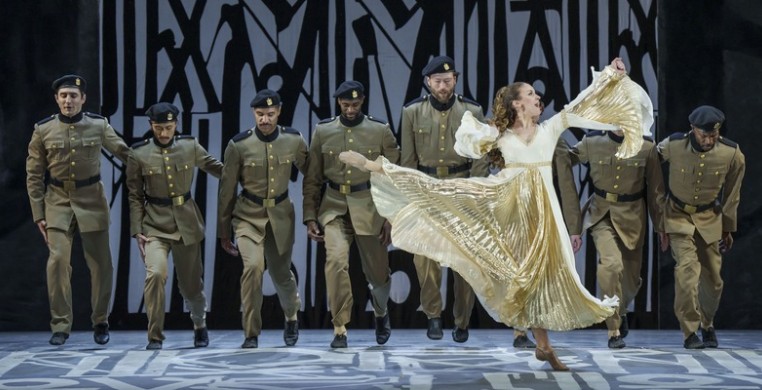UPDATE: The new seechicagodance.com will launch March 31st. Click here to learn more.
Jessica Lang speaks about relationship between dance and opera in “Aida”
Regarding opera, most remark on the exaggerated vocal styles of the artists, the deliciously ostentatious scenery and costumes… But what about the dancing?
You can’t think about opera without considering ballet’s impact on the art form. Although created in Italy during the Renaissance, the noble ballet style reached its epitome in the court of Louis XIV—no slouch of a dancer himself—in the mid-17th century. Ballet was integral to the development of opera and has remained an essential component, inspiring operatic works by composers such as Pyotr Ilyich Tchaikovsky and Giuseppe Verdi.
Lyric Opera Chicago continues the tradition of marrying dance to music in “Aida,” running through April 7. Directed by Francesca Zambello and composed by Verdi, the production presents dance as an important element within the story of the Egyptian General, Radamès (Russell Thomas), who relinquishes his status after falling in love with Aida (Michelle Bradley), the captive princess of their neighboring enemy.
 The company of "Aida" at Lyric Opera; Photo by Todd Rosenberg
The company of "Aida" at Lyric Opera; Photo by Todd Rosenberg
See Chicago Dance spoke with choreographer Jessica Lang about her work on “Aida,” the relationship between ballet and opera, and how she came to be interested in the genre.
Lang first felt the allure of opera while studying at The Juilliard School in New York City. “I was surrounded by so much talent in many areas of performing arts—musicians, dancers and opera singers,” says Lang. “I was inspired by my classmates and [opera] struck me as something I was interested in and found beautiful.”
It became apparent to Lang that opera, true to its roots, is an art form that encompasses a spectrum of art forms in a collaborative environment. “There’s a definite story, and you’re a part of that story, not the main attraction. I love the collaborative experience working with a director, working within my art form to enhance their vision of the storytelling.”
Lang’s choreography can be seen throughout the performance, serving as the denouement of the acts, as interstitial moments that set up the proceeding scenes, or in the background to augment the vocal expositions happening downstage.
Dressed in grey tank tops and brown slacks, or in forest green military uniforms, the dancers are the King’s elite guard, performing intricate military drills that showcase strength and precision through lofty jeté leaps into parallel line formations, then plowing through their own ranks with fists raised high.
The corps of dancers also adds to the scenery created by Artistic Designer RETNA, composed mostly of large installations of abstract circles and zig-zagging lines based on Egyptian hieroglyphics. In Act 4, guardsmen grab hold of long black ribbons attached to the ceiling, creating crisscrossing patterns that add depth to the symbols in the background. When they use these ribbons to bind the traitor Rademes, scenery, dance and narrative combine in an awesome spectacle.
 The company of "Aida" at Lyric Opera; Photo by Todd Rosenberg
The company of "Aida" at Lyric Opera; Photo by Todd Rosenberg
The dancers are an assembly of notable talent, including artists familiar to fans of Chicago dance—Sam Crouch (South Chicago Dance Theater, Hot Crowd), Vernon Gooden (Joel Hall Dancers, Deeply Rooted), Marcus Hardy (Inaside Chicago Dance, Chicago Dance Crash) and Chicago-native Jonathan Hart.
Featured amongst the ensemble is dancer Ann O’Donnell Passero, who several times takes center stage wearing a flowing gold dress, representing hope and joy during the culmination of Act 2, when the royal court convenes to celebrate their victory over Ethiopia. “Ann represents this hope, a ritual icon that the people honor and maybe pray to,” says Lang. “In the end, they lift her to the sky as it rains down gold in a beautiful moment of joy. There are rewards for being hopeful.”
This isn’t Lang’s first time working with both O’Donnell Passero, who danced in Lang’s company, Jessica Lang Dance, and performed in Lang’s “Stabat Mater” at the 2013 Glimmerglass festival, commissioned by then-director, Francesca Zambello.
Lang is thrilled to work again with Zambello on “Aida.” “What I love about Francesca is that she uses dance as a language throughout the opera. She doesn’t just hold it until the ‘triumphal scene.’ That’s too obvious. She puts it in nearly every scene. [Zambello treats dance] as a visual language that is used throughout. I think that might be of some surprise.”
This isn’t Lang’s first run in with the property. This version of “Aida” began at the San Francisco Opera in 2016 before being reset at the Washington National Opera, Seattle Opera and LA Opera. Despite multiple productions, Lang finds ways to keep the work fresh. “Every time we reapproach [Aida] there is a discussion about what should or could change from the production standpoint. I also let the artists in the room influence and inspire different interpretations of similar steps. There’s a map of what we’re going to do, but there’s freedom to have change happen.”
While many don’t associate opera with dance, they should, and Lang is passionate about the multi-faceted nature of the art form. “Opera envelopes the whole experience of the performing arts. Opera has dance, live music, singing… It’s something I find very inspiring.”
“Aida” runs through April 7 at Lyric Opera Chicago, 20 N. Wacker Dr. Remaining showtimes are April 1 at 7pm and April 4 & 7 at 2pm. Tickets are $59-$349 at lyricopera.org.


